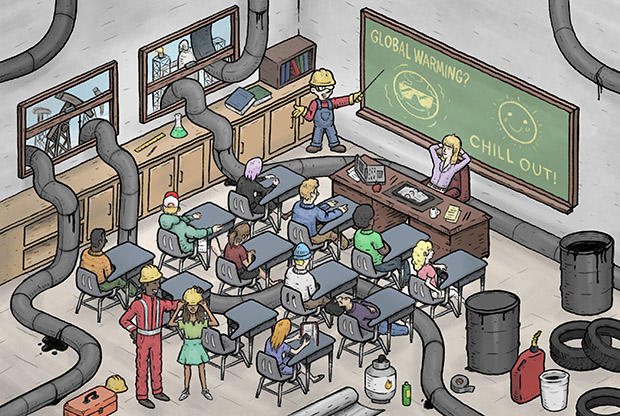
Oil’s Pipeline to America’s Schools
-
Jie Jenny Zou -
Joe Wertz

Illustration by Eben McCue
Jennifer Merritt’s first-graders at Jefferson Elementary School in Pryor, Oklahoma, were in for a treat. Sitting cross-legged on the floor, the students gathered in late November for story time with two special guests, state Rep. Tom Gann and state Sen. Marty Quinn.
Dressed in suits, the Republican lawmakers read aloud from “Petro Pete’s Big Bad Dream,” a parable in which a Bob the Builder lookalike awakens to find his toothbrush, hardhat and even the tires on his bike missing. Abandoned by the school bus, Pete walks to Petroville Elementary in his pajamas.
[module align=”right” width=”half” type=”aside”]This story is a collaboration with The Center for Public Integrity. Versions of this story also appear in The Guardian US and The Hechinger Report.[/module]
“It sounds like you are missing all of your petroleum by-products today!” his teacher, Mrs. Rigwell, exclaims, extolling oil’s benefits to Pete and fellow students like Sammy Shale. Before long, Pete decides that “having no petroleum is like a nightmare!”
The tale is the latest in an illustrated series by the Oklahoma Energy Resources Board, a state agency funded by oil and gas producers. The board has spent upwards of $40 million over the past two decades on K-12 education with a pro-industry bent, including hundreds of pages of curricula, a speaker series and an afterschool program — all at no cost to educators.
A similar program in Ohio shows teachers how to “frack” Twinkies using straws to pump for cream and advises on the curriculum for a charter school that revolves around shale drilling. A national program whose sponsors include BP and Shell claims it’s too soon to tell if the earth is heating up, but “a little warming might be a good thing.”
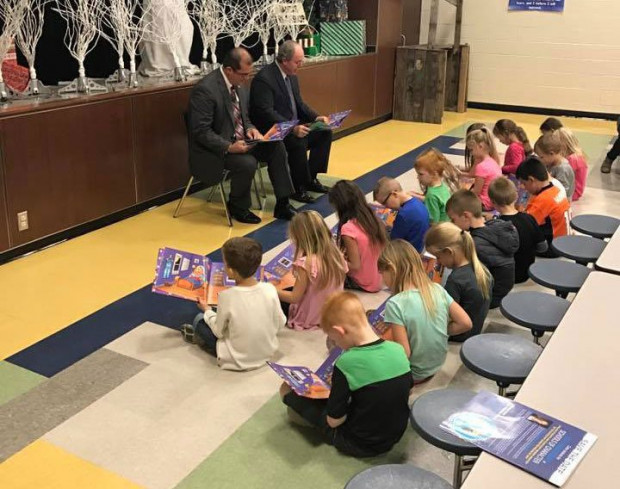
Oklahoma Energy Resources Board
State Rep. Tom Gann and State Sen. Marty Quinn read aloud to first graders at Jefferson Elementary School in Pryor, Oklahoma.
Decades of documents reviewed by the Center for Public Integrity reveal a tightly woven network of organizations that works in concert with the oil and gas industry to paint a rosy picture of fossil fuels in America’s classrooms. Led by advertising and public-relations strategists, the groups have long plied the tools of their trade on impressionable children and teachers desperate for resources.
Proponents of programs like the one in Oklahoma say they help the oil and gas industry replenish its aging workforce by stirring early interest in science, technology, engineering and math, or STEM. But some experts question the educational value and ethics of lessons touting an industry that plays a central role in climate change and air pollution.
Anthony Leiserowitz, director of the Yale Program on Climate Change Communication, likened industry-sponsored curricula that ignore climate science to advertising. “You’re exploiting that trusted relationship between the student and the teacher,” he said. Leiserowitz — whose research has focused on how culture, politics and psychology impact public perception of the environment — said fossil-fuel companies have a stake in perpetuating a message of oil dependency.
As early as the 1940s, the industry’s largest and most powerful lobby group targeted K-12 schools as a key element of its fledgling marketing strategy. By the 1960s, the American Petroleum Institute was looking to shake its reputation as a “monopoly which reaped excessive profits” and set out to cultivate a network of “thought leaders” that included educators, journalists, politicians and even clergy, according to an organizational history copyrighted by API in 1990.
The idea caught on. Hundreds of oil-and-gas-centric lesson plans are now available at the click of a mouse. The programs occupy a gray area between corporate sponsorship and promotion at a time when climate science has increasingly come under siege at the highest levels of government. On June 1, President Donald Trump, flanked by U.S. Environmental Protection Agency administrator – and former Oklahoma attorney general – Scott Pruitt, announced that the United States would withdraw from the Paris climate agreement.
“Teachers are taking their cues from the political situation around them,” said Glenn Branch of the National Center for Science Education, a nonprofit that advocates for climate-change and evolution education. He pointed to a survey that found teachers in Republican counties and states are less likely to teach the scientific consensus on global warming — regardless of the educator’s politics. “Teachers live in local communities, they’re sensitive to the needs and desires of the people paying their paychecks.”
Branch’s group supports wide-scale adoption of Next Generation Science Standards, a joint effort by states and educational organizations to revamp K-12 science that has met with political backlash since the standards were published in 2013. Oklahoma is among a dozen states that have opted for watered-down versions, sometimes omitting provisions on evolution and the anthropogenic causes of global warming. Along with Colorado, Kansas and Montana, Oklahoma legislators have also championed bills requiring that educators teach “both sides” of those scientific concepts.
A 2016 study confirmed that America’s youth receive mixed messages on climate change. Nearly a third of middle- and high-school science teachers nationwide have wrongly suggested global warming is naturally occurring. A quarter have spent as much time rebutting evidence of warming as they have presenting it.
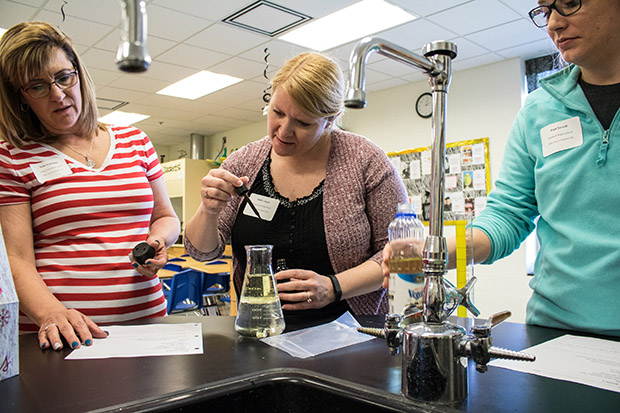
Joe Wertz / StateImpact Oklahoma
Teachers gathered at Choctaw High School for a workshop in April by the Oklahoma Energy Resources Board. Joe Wertz of StateImpact Oklahoma.
Freddie Fuelless and Oliver Oilpatch
Schools and libraries across Oklahoma have received more than 9,000 complimentary copies of “Petro Pete’s Big Bad Dream” since it was published last year. The story has been a hit with Jennifer Merritt’s students, who won the storytelling visit from lawmakers after submitting a photo to the energy resources board via Facebook. Posing on a jungle gym, the students clutched stuffed animals and footballs — their “favorite petroleum by-products.”
“It’s not some boring thing,” Merritt said of the board’s “Little Bits” curriculum for kindergarten through second grade, which features alliterative characters like Freddie Fuelless and Oliver Oilpatch. Without it, she said, “I probably wouldn’t have taught first graders about energy.”
Merritt is among 14,000 Oklahoma teachers who have attended workshops on how to use what the board calls its “innovative, one-of-a-kind science and energy curriculum in their classrooms.” Participants are reimbursed for supplies year-round and can register their classes for free museum field trips — so long as the exhibits highlight petroleum.
On a recent Saturday, a workshop was in session at Choctaw High School, east of Oklahoma City. The parking lot was bustling as teachers loaded their cars with heavy tubs, each stuffed with up to $1,200 worth of calculators, lab equipment and other materials. In classrooms, some teachers plotted oil-production trends while others watched bubbling brews simulating how the industry wrings oil from depleting fields.
In an email, board Chairman Danny Morgan wrote that the organization doesn’t use public funds and “does not function like a typical agency.” Under state law, half of its revenues from oil and gas producers are spent restoring abandoned oil wells. Morgan pointed to a board safety campaign aimed at preventing children from playing on dangerous pumpjacks that dot the state, writing, “if just one child is kept safe through the awareness this program created, it is well worth the effort.”
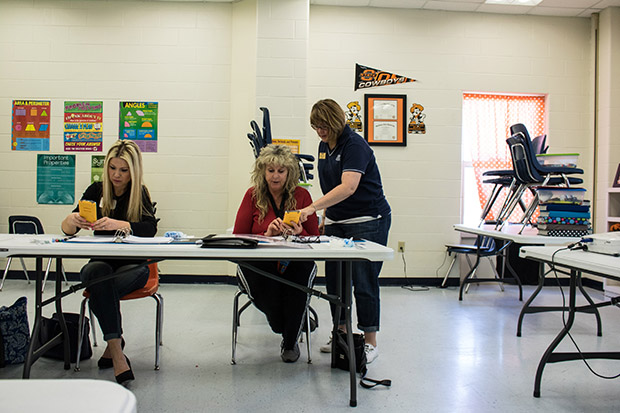
Joe Wertz / StateImpact Oklahoma
During the workshop, Oklahoma educators learned about oil production and other aspects of the petroleum industry.
While the board’s curriculum enlightens students about the benefits of “black gold,” their teachers are hard-pressed to find any information on climate change or other drawbacks of fossil fuels — even as Oklahoma struggles to curb a slew of man-made earthquakes tied to its fracking boom. Morgan, an oil company executive and a former state legislator, declined to say why the board’s materials fail to address global warming.
Cheerleading for the industry has been central to the energy resources board’s mission from the start. Lawmakers created the board in 1993 as a “privatized” state agency funded by a voluntary tax on local oil and gas producers to publicize the industry. Kansas, Illinois and Ohiofollowed suit with similar legislation.
But Oklahoma remains the epicenter of oil-industry puffery in the classroom. The board’s curricula are used in an estimated 98 percent of Oklahoma school districts and have been adopted in neighboring Kansas. Records show that Oklahoma’s energy resources board has pitched its programs and pro-industry ads to trade groups and legislators in Montana, Arkansas, North Dakota, Wyoming and Texas. Similar petroleum boards in Kansas, Illinois and Ohio declined to fulfill records requests filed by the Center.
Oklahoma’s board appears to have taken cues from the American Petroleum Institute — the country’s leading oil and gas lobby group, representing more than 625 companies. The plot of “Big Bad Dream” bears uncanny similarities to API’s 1996 educational film, “Fuel-less: you can’t be cool without fuel.” Records show that the board’s education director, who wrote “Big Bad Dream,” has ordered hundreds of copies of “Fuel-less” to distribute locally — most recently in 2013.
API’s vice president of communications delivered a special presentation to the board in 2012 on marketing strategies. The same year, an API lobbyist asked the board to host a fracking workshop on its behalf as part of the trade group’s effort to reach out to legislators, regulators and other stakeholders nationwide. Morgan wrote that the board did not participate in the workshop because API “never followed up on the request.” He added that the board itself doesn’t engage in lobbying.
Copied on API’s communications with the board was Bill Whitsitt, a Devon Energy executive who helped draft letters for then-state attorney general Pruitt. In 2014, The New York Times reported on Pruitt’s extensive industry ties — which included oil and gas companies, utilities and lobby groups.
Where the board draws the line between industry promotion and youth education is unclear. While it spent $3.5 million for K-12 efforts in 2016, roughly the same amount went to messaging it calls “public education.” Its contract with Oklahoma-based Brothers & Company — which creates its pro-industry commercials and some K-12 materials — forbids the advertising firm to perform work for other clients that “portrays the oil and natural gas exploration and production industry in an unfavorable light.” Brothers & Company counts among its clients Kansas Strong, an oil and gas marketing group similar to Oklahoma’s; apparel company Under Armour; and handgun maker Remington.
Last spring, Brothers & Company rolled out an ad campaign highlighting petroleum’s benefits and based on Alex Epstein’s “The Moral Case for Fossil Fuels.” Epstein is a libertarian writer whose work is popular with climate-change deniers and who falsely claims that rising carbon dioxide levels have yielded only “mild and manageable” warming.
A Brothers & Company official wrote in an email that the firm’s work for the energy resources board helps “citizens better understand domestic oil and natural gas production.”
The firm also developed videos on Oklahoma’s “seismicity issue” after the state was rattled by more than 900 earthquakes in 2015 and polls showed the matter was dampening the industry’s “brand.” Energy resources board members insisted that no cause for the seismic uptick be cited in the videos. Records show that Morgan cautioned his colleagues to be “careful not to state anything that someone might misconstrue and attempt to use in a court case.” Soon afterward, state officials acknowledged that underground wells used for fracking waste likely were to blame.
‘We need oil. We need gas.’
Carla Schaeperkoetter, the energy resources board’s education director, is the creator of “Big Bad Dream” and “Lab Time with Leo”— a video series featuring a bowtie-wearing scientist not unlike Bill Nye the Science Guy. Instead of exploring fundamentals like the solar system, Leo delves into the nuances of oil refining, teaching kids as young as 8 about “fractional distillation” and “residuals.”
Like her predecessor, Schaeperkoetter doesn’t have any teaching experience and isn’t a state employee. Board staff, including Schaeperkoetter, are consultants hired by a private foundation affiliated with the Oklahoma Independent Petroleum Association. The state trade group is listed as a partner of the Independent Petroleum Association of America, a lobbying organization that worked closely with API to roll back federal rules on fracking.
Schaeperkoetter’s name appears on curricula reassuring teachers that “companies are spending more dollars protecting the environment than drilling new wells.” A jump-rope rhyme reads, “We need oil. We need gas. Where are the oil products in our class?” And a high school guide asks students to create 30-second commercials on how “new technologies to find oil and natural gas will help America be energy independent.”
Charles W. Anderson— a professor at Michigan State University who studies environmental literacy and develops curricula — said the board materials are upfront about their pro-industry agenda but only tell “half the story” by omitting global issues like climate change in favor of niche oil knowledge. “The children of Oklahoma are getting a raw deal — they are getting educationally ineffective materials teaching content that will be of little use to them if they want to leave the state,” Anderson said.
Students also are being sold short in more immediate ways: an increasing number of Oklahoma districts are adopting four-day school weeks amid budget cuts due partly to tax breaks for the petroleum industry. “The state government of Oklahoma, in its wisdom, has decided that oil and gas companies should have a whole lot of money and schools should have hardly any money,” Anderson said. “That’s a social decision that values oil and gas extraction over the public good of public schools.”
Oklahoma’s State Department of Education promotes energy board lessons online and in newsletters. Though the curricula are described by the board as having been developed in “a collaborative effort” with the state, the education department has “not reviewed, endorsed or had any oversight” over the materials in two decades, spokeswoman Anne Price said.
“We value curricula that align to our state standards and are at no cost to educators, but ultimately we encourage educators to investigate further to choose what is best for their classrooms,” Price wrote in an email.
Without explicit guidance, experts say, it’s difficult for educators to assess which materials are appropriate — especially elementary-school teachers who don’t have extensive science training. Historically, K-12 energy curricula have been scarce, leaving a window open for groups looking to mold young minds.
“This provides an opportunity for anyone who has a particular point of view, whether it’s an oil company or an environmental concern,” said David Evans, executive director of the National Science Teachers Association, which co-developed the Next Generation Science Standards. Both the association and the standards are supported by corporate money.
The standards specify which concepts students should grasp by grade level — like the greenhouse effects of gases like carbon dioxide and methane — but don’t provide curricula, leaving educators to find or create lessons themselves. So far, the standards have been adopted by 18 states and the District of Columbia.
When it comes to climate change, Evans urges teachers to stick to facts and avoid politics. “Science is about understanding the physical world that we live in,” he said. “We wouldn’t say, ‘Why should people understand gravity?’”
But education is inherently political, said Nicole Colston, a researcher at Oklahoma State University who has studied overlap between groups that push against evolution and climate change education. “It’s this implied thing that you can’t talk about climate change,” she said of her interviews with Oklahoma teachers. “It’s almost, like, impolite or uncomfortable.”
Prominent Oklahomans like Pruitt and Republican U.S. Sen. James Inhofe are climate-science deniers, a fact not lost on the state’s residents. Just 46 percent of adult Oklahomans believe global warming is caused mostly by human activities, below the national average of 53 percent, according to 2016 data from the Yale Program on Climate Change Communication.
In 2014, Oklahoma lawmakers tried but failed to block the state board of education from adopting its version of Next Generation Science Standards. The same year, a state law was passed to give local school districts ultimate authority over curricula.
Merritt said she chose to use energy resources board materials because they were age-appropriate, factual and free. “It’s just a way of life,” she said of the curriculum’s laser focus on petroleum. “We live in Oklahoma. There’s a lot of oil.”

The Hagley Museum
“The Magic Barrel” was a promotional video produced by DuPont for the American Petroleum Institute. The film hyped petrochemicals like Freon-12.
‘The Magic Suitcase’
Smiling broadly, the host pulls item after item from two large drums. Plastic wrap, shingles, Lucite — all “modern day miracles” made possible by oil and petrochemicals. Three minutes into the muted-color film, the man in the tan suit and plaid tie pours Freon-12 from a pressurized canister.
“You may be able to note that it is boiling violently, just as water would boil on a stove,” he says, holding up a glass of the clear liquid. “Yes, it’s a safe refrigerant. I’ll just pour some on my clothing. And now, watch the frost appear. I’ll blow on it. Oh, it’s cold all right.”
Scientists now know Freon is far from benign. Forms of the coolant are still being phased out after research in the 1980s found it was rapidly depleting the Earth’s ozone layer. The volatile chemical is moderately toxic when inhaled.
Shot in the 1960s, “The Magic Barrel” promoted a one-man show of the same name developed by chemical giant DuPont for the American Petroleum Institute. By 1954, DuPont had trained 600 oil-industry workers to deliver the show-and-tell in classrooms, with 40 assigned to New York’s 230 middle schools and high schools. The lecture was a fixture of Oil Progress Week, API’s bygone annual celebration of all things petroleum.
Half a century later, a version of the demonstration — which uses a suitcase instead of a barrel and originally targeted women’s groups — lives on. YouTube videos show the talk being delivered at elementary schools in West Virginia, a state embracing natural gas amid coal’s decline. “The Magic Suitcase” also has made the rounds in Texas, Wyoming, Louisiana, and most recently in Pennsylvania and Colorado.
While oil and gas is not the only industry to market to young audiences, it is among the most prolific and enduring. Records detail API’s early efforts to rehab the industry’s image by influencing educators. In the 1950s, companies like DuPont worked hand in hand with API’s budding public-relations division, which sent “flying squadrons” of industry representatives to schools nationwide, getting two million copies of API lessons into classrooms.
Inspiration for these squadrons sprang from a 1946 study surveying 10,000 Americans, according to the 1990 API history. The document’s author wrote that, “the more people knew about the petroleum industry, the more favorable were their feelings towards it.” To combat the industry’s negative reputation, the study suggested “a well-directed program of public education was the right medicine to bring about a cure.”
Hill & Knowlton — the public-relations firm that would later help the tobacco industry fend off cancer claims — was brought on to strategize. The firm surmised that the “petroleum industry’s legislative difficulties could be traced to misunderstandings by government and the public” and laid out a plan to cultivate ‘“thought leaders’ or ‘opinion molders’ — educators, editors, columnists, the clergy, business and financial leaders and, of course, key people in government,” according to the 1990 document.
In 1960, educators helped revamp API materials that eventually made their way into 25,000 secondary schools. Advertisers were hired to ghost-write scripts hyping oil for popular children’s programs like Art Linkletter’s “House Party.” The widely televised “Odyssey: A Quest for Energy,” was among dozens of educational videos made available through API’s vast regional network.
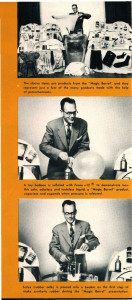
The Hagley Museum
DuPont promoted “The Magic Barrel” film in a brochure.
The 1982 film examined renewable energy, but made the best case for fossil fuels — urging that offshore drilling be expanded “into deeper waters” and that federal lands be opened for coal mining in promotional brochures sent to some 14,000 schools. Within months, more than 1,300 schools wanted to screen “Odyssey.” Indiana officials ordered enough kits to show the film to every high-schooler in the state. API’s public relations team meticulously tracked “Odyssey’s” reach, estimating that at least five million Americans saw the film.
API did not respond to requests for comment.
API’s message was amplified with the help of an unlikely ally — the National Science Teachers Association, which boasts some 55,000 members of mostly K-12 educators. The association worked closely with API and utility executives during the 1970s to develop K-12 energy curricula. When federal funding dried up in the 1980s, the association turned to corporate sponsors to cover costs.
As pressure to act on global warming mounted during the 1990s, API ramped up its strategy to quiet critics, including leveraging its relationship with the teachers association. Months after the language of a global climate treaty known as the Kyoto Protocol was finalized in 1997, an internal memo obtained by The New York Times laid out API’s plans to infuse doubt about climate change into K-12 materials. Less than a decade later, the association garnered criticism for distributing API’s “Fuel-less” film to teachers while API funded the association’s educational website for kids.
Some of API’s largest corporate members, including Chevron and Shell, remain top sponsors of the teachers association. Evans, who has led the association since 2013, said he was unable to comment on the organization’s past but defended the group’s independence. “It’s NSTA that decides what the content should be,” he said.
‘Win-win’
With only 14 seniors, the class of 2016 came nowhere near filling a gymnasium in Salineville, Ohio — a town of 1,300 about 50 miles west of Pittsburgh. “In this region, there are phenomenal opportunities,” said Rhonda Reda, delivering the keynote speech at the Utica Shale Academy graduation. “Go out there and make a difference.”
Named after the rock formation that stretches from eastern Ohio to Canada, the tuition-free charter school founded in 2014 promises “real opportunity” outside of “traditional settings.” Instead of hitting textbooks, students work on drilling certifications and intern for oil companies. Attendance is flexible: students must spend more than half their time on campus — an increase from a previous requirement of at least 15 hours weekly.
The academy rents space from two high schools. A third location for K-12 students was shuttered last June after just a year in operation. The academy’s website prominently displays the logos of corporate partners like Chesapeake Energy, whose executives meet with school administrators to help carve out the curriculum for the year.
One of the academy’s most prominent sponsors, the Ohio Oil and Gas Energy Education Program—led by Reda — has stirred up criticism for its pro-drilling message. Like the Oklahoma energy resources board, the Ohio group is industry-funded, state-sanctioned and conducts free teacher workshops. In a meeting with state legislators in 2016, Reda said that 2,700 teachers statewide had attended the workshops since 1997.
Lisa Hoyos of Climate Parents, an affiliate of the Sierra Club that successfully petitioned Radio Disney to sever ties with Reda’s group in 2014, criticized educational content that pushes petroleum’s benefits but sidesteps its downsides. “They’re basically indoctrinating children,” she said of the Ohio program. “All the materials [the program is] putting out are about oil and gas, which are the chief culprits, along with coal, in causing climate change.”
Before founding the Ohio program in 1997, Reda handled public affairs for the state’s Oil and Gas Association. She sits on the communications committee for the Independent Petroleum Association of America, which created Energy in Depth — a website run by a public-relations firm that aggressively disputes industry criticism and news media reports, including investigative work done by the Center for Public Integrity. Reda’s program helped launch Energy in Depth’s Ohio section in 2011.
Reda declined in an email to elaborate on her relationship with lobby groups, but wrote that her organization “does not utilize any taxpayer dollars” and “does not lobby the legislature or take positions on regulatory or public policy.” She added that her program “may elect on occasion to collaborate with other oil and gas groups, educational institutions and other experts on specific projects.”
Reda’s group has helped develop lessons for the National Energy Education Development Project, or NEED, a nonprofit that publishes thousands of pages of K-12 energy lessons online. A 2015 NEED lesson teaches students how to ‘frack’ a frozen layer cake using chocolate syrup and a syringe-like turkey injector — not unlike Ohio’s demonstration using Twinkies.
Oil and gas companies are among NEED’s most prominent backers. ConocoPhillips has sponsored NEED workshops since 2008, exposing educators nationwide to packets like “Oil, Gas and their Energy,” and “Exploring Oil and Gas.” A 2014 NEED guide tells of Sue Ann, who is a sticky pool of oil waiting to be freed, and Stacey, who wants to follow in her father’s footsteps and become a blowout specialist on an offshore rig.
Executive Director Mary Spruill said NEED teams up with industry groups to train future workers, but the groups don’t play a substantial role in developing content. “We don’t send drafts to our partners,” she said.
Like Reda, Spruill does not have an education or science background. Lessons from both their groups have been adapted by “Arkansas Energy Rocks!”, a website dedicated to teaching kids about the “thriving oil and natural gas industry.” Lessons include “Just a little oil spill,” which uses drops of vegetable oil in a pie plate filled with water to simulate an offshore oil spill, and “Persuasion POWER!” which highlights the legislative process with a congressional press release titled, “Consumers desperate for new natural gas pipelines.” It’s unclear how many schools are using the materials.
The website is a project of the Arkansas Energy Education Foundation, a nonprofit arm of the Arkansas Independent Producers & Royalty Owners. The program’s logo and website are registered to the American Petroleum Institute. Listed as a contact for an all-expenses-paid teachers’ workshop in 2015 promoting “Arkansas Energy Rocks!” was the personal email address of Paige Miller, an API public-affairs specialist based in Little Rock.
Spruill works closely with the Independent Petroleum Association of America, sitting on an advisory board for the lobby group’s five “Petroleum Academies.” IPAA, whose chief executive and lobbyist, Barry Russell, is co-chair of the advisory board, has billed the academies as a “win-win” for high schoolers and oil companies in Houston and Fort Worth.
Students are encouraged to put themselves in industry leaders’ shoes by competing for lucrative leasing deals as fictional oil companies and delivering presentations on topics like “clearing misconceptions of the oil and gas industry.”
Despite the hard sell, some students are unsure of their prospects in the petroleum industry. The ongoing oil-price slump has made jobs in the industry scarce and advancements in automation are expected to accelerate the trend.
Even in a state built on fossil fuels, other career options have grown more appealing. Having interviewed administrators at the academies, the Houston Chronicle reported last year that “students were gravitating more toward climate-friendly subjects like algae-based biofuel and super-efficient tiny houses.”
Joe Wertz, a reporter with StateImpact Oklahoma, contributed to this story.
